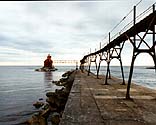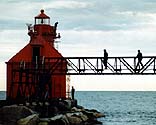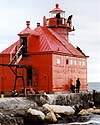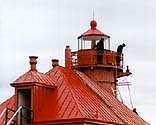 |
 |
 |
 |
| Sturgeon Bay Ship Canal Pierhead Light | Seeing The Light |
|
|
|
|
Historical
Information Named from the huge primeval fish that used to frequent the bay, it was said that the sturgeon were once so plentiful in the bay that boats would literally run aground atop heaps of them. At times they were reportedly speared, shot, netted and left to rot, the foul odor of their decaying carcasses choking the air.
After It was determined that the costs associated with constructing the canal could be recouped through the collection of tolls from vessels using the passage, a group of local businessmen formed the "Sturgeon Bay and Lake Michigan Canal and Harbor Company," and began work on the 6,600 foot-long canal in July 1872. While the way was not open for larger commercial vessels for a full ten years, small draft craft began using the canal as early as 1880. With the huge increase in vessel traffic expected as a result of the planned completion of the Canal, the Lighthouse Board recommended to Congress that a light and fog signal be built on the north breakwater that was planned to protect the eastern entrance of the Canal. Congress reacted just in time, as the monies for construction were finally appropriated as work on the Canal was reaching completion in 1881. Work began on the pier late in the summer of the same year, when a lighthouse tender deposited a construction crew and the necessary supplies. The first lighthouse to grace the pier was a simple twenty-nine foot open-frame tower, equipped with a fixed Sixth Order Fresnel lens displaying a red light. In order to make the tower more readily visible, it was given a coat of bright white paint. Atop the pier, the crew erected an elevated catwalk connecting the tower to the shore, designed to provide the keeper some distance above the waves which frequently pounded over the pier. Rufus M. Wright was selected as the station's first keeper, and he made his first of many tips along the catwalk and into the tower, to display the light for the first time on May 15, 1882.
Two years later, the second fog signal was completed, along with a keepers dwelling on shore. That same year, the Lighthouse Board deeded a parcel of land to the Lifesaving Service, for the construction of a lifesaving station just North of the pier. The pierhead light underwent significant renovation in 1903, when the fog signal buildings and pierhead light were incorporated into the existing large forty-three foot tall combination lighthouse and fog signal building. Equipped with the Sixth Order lens from the old tower, this building too was originally painted white, but was repainted in its' current bright red hue at same time thereafter. Keepers of this Light We arrived at the east entry to the Sturgeon Bay Ship Canal at around 8.00am, and once we made our way through the Station grounds and out to the pier, we found we were not the only people making our way out the pier. We found that the crew of the SUNDEW had arrived in town to paint the tower, and as we walked along the pier, a total of ten Coasties made their way along the catwalk above our heads. It's great to see that in these days of reduced funding and excessing, the USCG can still find time to keep the lights putting their best face forward. Finding this
Light Park here, and walk into the Coast Guard Station. The signage is very confusing, and it may appear to you that when you enter the station, that you are violating the law. Rest assured, that there is a path leading from the front gate to the pier, and the public is welcome to use this path to gain access. Be sure to stay on the paved road, and continue by the Canal Station tower to the waterfront. This road will lead you right onto the pier. Reference Sources |
This page last modified 12/07/2003